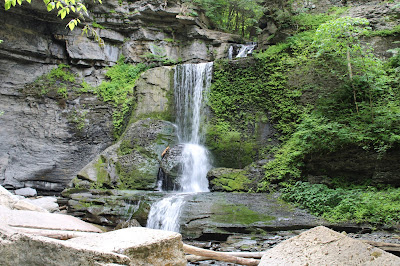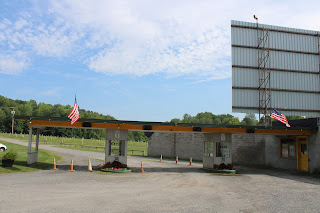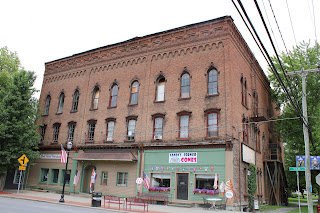 |
| Watkins Glen State Park |
Sometimes there are words in English that we take for
granted and do not ponder the etymology or full meaning of it. Glen, a term
used to describe narrow valley in the mountain districts of Scotland and
Ireland, was one of those words for me. Since the appearance of the word in
English in the sixteenth century, it has been applied further afield, including
in the Finger Lakes region of New York.
Voted as the third-best state
park in the United States in 2015, Watkins Glen, with its many waterfalls
and accessible location, is a popular destination. Its popularity has not
detracted from its beauty, but the sheer volume of visitors can make the
photographer frustration frustrated looking for the perfect shot of a
waterfall. Long and narrow, the park encompasses the glen created by Glen
Creek, which is a name that seems somehow redundant given the definition. The
most popular trail in the park, the Gorge Trail, is a mile-and-a-half long and
surveys 19 waterfalls. I do not think it enters most of the visitors’ minds
that there is a 500-foor change in elevation over the course of the trail.
Thus, at the upper end of the trail, bedraggled people who are not accustomed
to walking, or wearing inappropriate shoes for the occasion, area readily
evident struggling to finish the trail.

We drove the picturesque route between Seneca Falls and
the village of Watkins Glen, not realizing that there was a lot of farmland and
not many places to stop for services. As we approach the south end of Seneca
Lake, we passed winery after winery, with an occasional brewery thrown in, with
gorgeous views of the valley and the lake. One can only imagine that the
weekends during the summer were incredibly busy. After research, I had decided
to enter at the park’s upper entrance. A nice location, with large shade trees
and away from the crowds of the main entrance. As a result, for the most part,
we were walking against the line of people, downstream as it were. People could
catch a tram from the upper parking lot to the main entrance, thus the traffic
downstream was not as significance. We could enjoy the falls without increasing
fatigue from a steady upward climb.

Arriving at the park’s main entrance, which is adjacent
to the center of the village, signs illustrate the history of the park and
area. The state park, as we know it today, was originally developed opened by George
Freer, a private entrepreneur, with the marketing of newspaper editor Morvalden
Ells, on 4 July 1863. After another owner, the State of New York acquired
the land in 1906, and took over the operation of the park in 1911. After a
devastating flood in 1935, prompted by 12 inched of rainfall in three hours,
the park was rebuilt by the Civilian Conservation Corps, which was largely
responsible for the bridges and paths that walkers on the Gorge Trail use
today.
Of course, prior to that, the land was part of the
indigenous Seneca homelands, who fished and farmed the area as part of the
larger Iroquois (Hodinöhsö:ni’) Confederacy. With the arrival of European colonist,
conflict and hardship ensued, and the land gradually became the possession of
the white people. This history is recognized, no doubt belatedly, with a statue
of a Seneca man and woman near the main entrance of the park.
The South Rim trail would be an interesting walk because
it is part of the 584-mile Fingers Lake
Trail, running from the Catskills in the east to the Allegheny National
Forest in western New York. But this would not have taken us back to our car.
Instead, we decided to take the North Rim Trail back, which until recently
known as “Indian Trail,” perhaps the name change is a nod toward more cultural sensitivity.
The trail begins with steps that lead to the rim of the gorge with views of the
creek and trail running below, then a gradual ascent back to our parking spot. It
was devoid of most people; however, we encounter a few walking their dogs who
are not allowed on the Gorge Trail. The trail offered an opportunity for quiet
reflection that the rushing waters, with the adrenaline rush that inevitably develops,
and the large number of people do not. Emerging from months of social
distancing, it is difficult to transition back to crowded noisy places.
Besides, we enjoyed the chipmunks darting back and forth and squealing in angst
and nervousness as we approached.
After our hike we wandered in the village for a little
while, finding an old
movie theater, a depression era post office with its artwork removed, and a
series of small shops. Working our way back toward Moravia and Skaneateles, we
serendipitously saw Ithaca Falls and pulled over to explore. The creek supplied
power to several industries in the early nineteenth century, and easily
accessible by foot, but finding a parking spot was more challenging. A little
further we stopped at a relaxing brewpub, Salt Point Brewing Company, for
pizza and appetizers in the early evening.
 |
| Ithaca Falls (Ithaca, NY) |
The following day found us at Fillmore Glen, a lesser
known although intriguing state park in Moravia. Named after the thirteenth
president of the United States, Millard Fillmore, the park sits near the
southern end of Owasco Lake. Fillmore was president during the early 1850s and
was the last person from the Whig party to serve in the office. Later, he joined
and became a leading figure in the American Party as its nominee during the
1856 election. The party was popularly known as the “Know-Nothing” Party. The
core tenants of the party were anti-immigrant and particularly anti-Catholic
policies. During the time of increased Irish immigration, largely because of
the 1840s Famine, the Know-Nothings sought to deny entry and citizenship
fearing an undermining of American culture, religion, and wellbeing. When asked
about nativism, party members were instructed to reply that they “knew nothing”
of the particularly reprehensible views about Irish and Catholics.
 |
| The Cow Sheds' (Fillmore Glen State Park) |
None of this history is recounted in the park. Instead, a
replica cabin of Fillmore’s boyhood home sits largely disregarded by most
visitors. The primary attraction of the park is the beautiful gorge, lightly
traveled, with several waterfalls feeding Owasco Lake. In terms of states
parks, Fillmore Glen is a nice counterpoint to Watkins Glen. Quiet,
uncomplicated, with abiding beauty, it offers challenging hikes because of the
landscape and the opportunity to observe and reflect.


















































